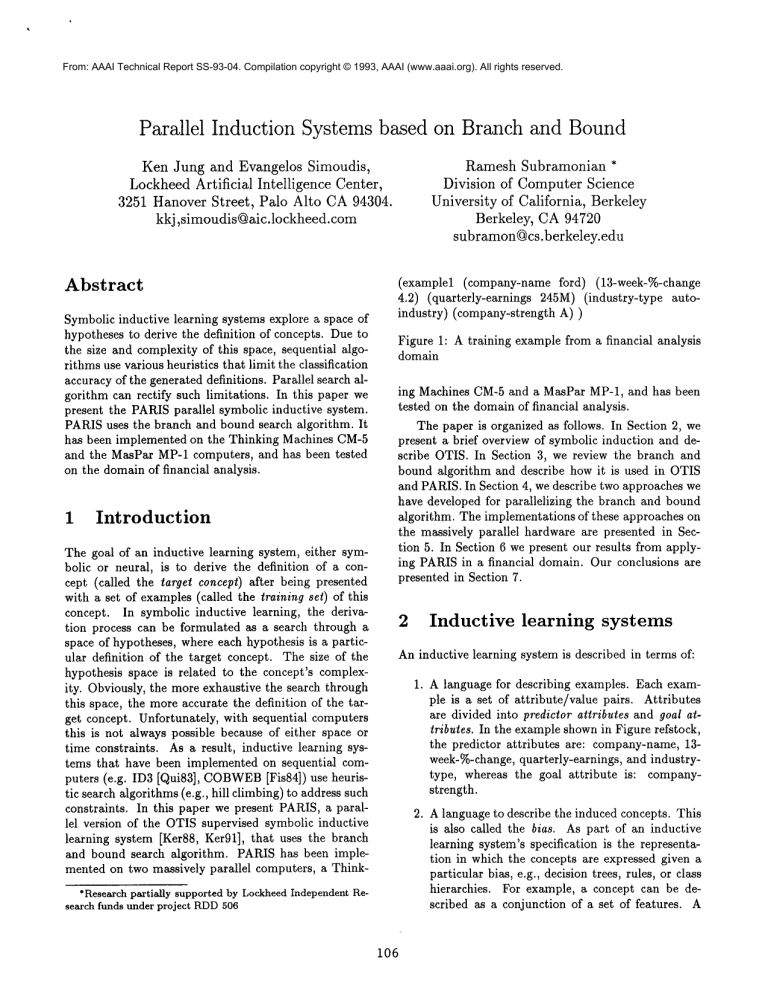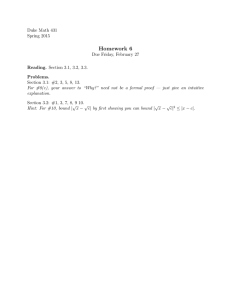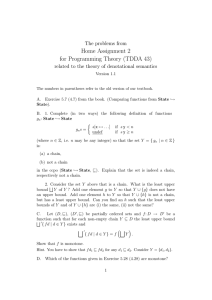
From: AAAI Technical Report SS-93-04. Compilation copyright © 1993, AAAI (www.aaai.org). All rights reserved.
Parallel Induction Systems based on Branch and Bound
Ken Jung and Evangelos Simoudis,
Lockheed Artificial
Intelligence
Center,
3251 Hanover Street,
Palo Alto CA 94304.
kkj ,simoudis@aic.lockheed.com
(examplel (company-name ford) (13-week-%-change
4.2) (quarterly-earnings
245M) (industry-type autoindustry) (company-strength A)
Abstract
Symbolic inductive learning systems explore a space of
hypotheses to derive the definition of concepts. Due to
the size and complexity of this space, sequential algorithms use various heuristics that limit the classification
accuracy of the generated definitions. Parallel search algorithm can rectify such limitations. In this paper we
present the PARISparallel symbolic inductive system.
PARISuses the branch and bound search algorithm. It
has been implemented on the Thinking Machines CM-5
and the MasPar MP-1 computers, and has been tested
on the domainof financial analysis.
1
Ramesh Subramonian
*
Division of Computer Science
University of California,
Berkeley
Berkeley,
CA 94720
subramon@cs.berkeley.edu
Figure 1: A training example from a financial
domain
analysis
ing Machines CM-5and a MasPar MP-1, and has been
tested on the domainof financial analysis.
The paper is organized as follows. In Section 2, we
present a brief overview of symbolic induction and describe OTIS. In Section 3, we review the branch and
bound algorithm and describe how it is used in OTIS
and PARIS.In Section 4, we describe two approaches we
have developed for parallelizing the branch and bound
algorithm. The implementations of these approaches on
the massively parallel hardware are presented in Section 5. In Section 6 we present our results from applying PARISin a financial domain. Our conclusions are
presented in Section 7.
Introduction
The goal of an inductive learning system, either symbolic or neural, is to derive the definition of a concept (called the target concept) after being presented
with a set of examples(called the training set) of this
concept. In symbolic inductive learning, the derivation process can be formulated as a search through a
space of hypotheses, where each hypothesis is a particular definition of the target concept. The size of the
hypothesis space is related to the concept’s complexity. Obviously, the more exhaustive the search through
this space, the more accurate the definition of the target concept. Unfortunately, with sequential computers
this is not always possible because of either space or
time constraints. As a result, inductive learning systems that have been implemented on sequential computers (e.g. ID3 [QuiS3], COBWEB
[Fis84]) use heuristic search algorithms (e.g., hill climbing) to address such
constraints. In this paper we present PARIS,a parallel version of the OTIS supervised symbolic inductive
learning system [Ker88, Ker91], that uses the branch
and bound search algorithm. PARIS has been implemented on two massively parallel computers, a Think-
2
Inductive
learning
systems
An inductive learning system is described in terms of:
1. A language for describing examples. Each example is a set of attribute/value pairs. Attributes
are divided into predictor attributes and goal attributes. In the example shownin Figure refstock,
the predictor attributes are: company-name,13week-%-change,quarterly-earnings, and industrytype, whereas the goal attribute is: companystrength.
2. A language to describe the induced concepts. This
is also called the bias. As part of an inductive
learning system’s specification is the representation in which the concepts are expressed given a
particular bias, e.g., decision trees, rules, or class
hierarchies. For example, a concept can be described as a conjunction of a set of features. A
*Researchpartially supported by LockheedIndependentResearch funds under project RDD
506
106
(rulel (> 13-week-%-change 0) (industry-type
industry) ---* (company-strength A))
auto-
Figure 2: An induced rule
(rulel (> 13-week-%-change 0) (industry-type
autoindustry) (quarterly-earnings
245M) --+ (companystrength A))
Figure 3: A specialization of the rule1
rule from the financial
in Figure 2.
,
.
analysis domain is shown
An algorithm for searching the hypothesis space
and thus implementing the bias. For example, hill
climbing, branch and bound, and gradient descent
are commonlyused search algorithms.
A matching predicate to evaluate how well each
hypothesized definition
of the concept being
learned can predict the values of the goal attributes of previously unseen examples.
The inductive learning task proceeds as follows. The
inductive learning algorithm receives a set of examples,
each of which is labeled as being an instance of a particular concept. Given a particular bias and the algorithm
that implements this bias, the inductive learning algorithm tries to automatically create definitions for these
concepts so that previously unseen examples can be correctly assigned to the corresponding concept.
2.1
Mitchell’s formulation of the inductive task requires
that solutions be consistent. This requirement implies
that (1) the training instances contain no errors; and
(2) it is possible to formulate a correct description
the target generalization within the given generalization language. OTIS deviates from this requirement,
allowing instances to be misclassified and allowing for
the fact that there may be no consistent solution. Experts are not always consistent in classifying instances,
especially border line calls, giving rise to the need for
second opinions! An induction system that does not
allow for such errors might be overly optimistic in its
requirements on the training set.
As was mentioned above, inductive algorithms need
to be parallelized in order to address time and space
issues associated with the induction task. In particular,
inductive algorithms must be able to search larger hypotheses spaces, deal with data sets of ever increasing
size, and perform faster, at least, the induction operations. While the operations performed by neural networks have been parallelized, symbolic induction algorithms have not yet been parallelized. Symbolic induction algorithms, however, have three advantages over
their neural networkequivalents. First, the concept definitions produced by symbolic induction systems are understandable by humans and can be used by a problemsolving componentto explain howit reached its classification decisions. Second, symbolic induction systems
can accept examples that are described in terms of both
nominal and numeric values. Finally, symbolic induction systems can utilize explicit knowledgeto facilitate
the induction process by expediting it and/or increasing
the accuracy of each concept’s definition.
OTIS
The inductive learning system OTIS accepts examples
that are described as sets of attribute/value pairs, defines concepts as conjunctions of features, and represents a concept as rules. OTIS uses a variant of the
branch and bound algorithm to search the hypothesis
space. During the search process, OTIS either proposes
a new hypothesis (rule) or modifies an existing one.
There are three basic ways in which hypotheses are modified: specialization, generalization and constructive induction. Specialization involves making a hypothesis
more specific. For example, the rule of Figure 2 can be
specialized to the one shownin Figure 3.
Generalization is the opposite. Constructive induction is the process of extending the original concept description language by creating new descriptors.
For example, the term "electronics-industry"
could
be created from the values "computer-industry," and
"semiconductor-industry" of the attribute "industrytype."
107
2.2
PARIS
Wehave developed the PARISsymbolic inductive learning system that is based on the OTIS system in that
it uses the branch and bound algorithm to search the
hypothesis space. PARISaccepts examples that are described as vectors of attribute/value pairs, defines concepts as conjunctions of features. An instance is represented as a vector Ct is a vector Ct = {v~, v~,...v~}
where v~ E ~, with ~ being the set of values that
attribute j takes in the membersof the training set. A
definition of a concept is similar to an object except that
(i) i j E Y)U {?}where ?. i s t he "don’t care " symbol and
(ii) the goal attribute is set to a given value, whichrepresents the concept being learned. The heart of PARIS
is a parallel implementation of the branch and bound
algorithm we describe in the next section. PARIScan
currently define with the definition of one concept at a
time.
Similar to OTIS, PARISdoes not attempt to find a
consistent definition of the target concept. This requirement presents a problem since the quality of the created
definitions cannot be established in absolute terms. For
this reason we associate a cost function with each concept definition. The cost of a concept definition is the
fraction of false positives and false negatives produced
after using this definition on the membersof the training set. False positives and false negatives are weighed
differently since usually the relative cost of these two
types of errors, called apos and aneg, are different. The
values for apo8 and aneg are determined by a domain
expert. Given a training set and a target concept (goal
attribute), PARIStries to induce the minimumcost definition of the target concept.
PARIS’ bias prefers the most general concept descriptions. For this reason, whenevernecessary, the cost
function can include the term aL x L(C), where L(C)
is the length of the concept definition, defined as the
numberof precisely specified values, i.e., no "don’t care"
symbols. The precise value of aL is problem-dependent.
As an example, a training set might include the
instances (Red, Fruit, Light) and (Red, Vegetable,
Heavy). A target concept may be of the form (Red)
and a definition of that concept might be (Red, Fruit,
?). What this means is that when presented with
new instance, if the second attribute is Fruit, then it is
classified as Red; else, it as classified as non-Red.
3
The Branch and Bound Algorithm
is initially set to infinity. Every partial solution whose
cost is greater than the maintained bound is removed
from the set of partial solutions. An efficient implementation of the branch and bound algorithm requires the
use of a heap.
3.1
Branch
and
Bound
in
OTIS
OTIS searches the hypothesis space using the "bestfirst" variation of the basic branch and bound algorithm.
OTISmaintains in an agenda the list of tasks associated
with modifying a concept’s definition. Each task is assigned a score by the agenda evaluation function. This
function takes into account the classification accuracy
of each definition (rule) on the training set, and the
conciseness of each definition (recall that the general
definitions are preferred over the more specific ones).
During each iteration, the task with the highest score
is removed from the agenda and executed resulting on
a new definition. Every new definition is first evaluated using a set of heuristics, and is either added to the
agenda or discarded based on the evaluation’s results.
This process terminates when the agenda is empty or
the user decides to terminate the search.
3.2
Branch
and
Bound
in
PARIS
PARISuses two cost functions. The first, provides the
cost of a complete definition Cz (complete solution) and
is defined as:
Cost(Cl) -- ~=~ f(G,, Ij) where Gi is the goal attribute, Ij is the name of jth example in the training
set,
Since Branch and Bound is a well-known heuristic
search algorithm, we describe it briefly here (see [Bal85]
for details). The algorithm has two prerequisites. First,
it must be possible to specify the cost of both the partial and the complete solutions to the problem being
solved. Second, the cost function must be monotonic,
i.e., the cost of all extensions of a problem’spartial solution should always be greater than or equal to the partial solution being extended. Therefore, the cost function provides a lower bound on the cost of all complete
solutions that can be generated from each partial solution.
The branch and bound algorithm evaluates the cost
of the set of available partial solutions. It selects the solution with the lowest cost (bounding step), and derives
a new set of partial solutions (branching step). If the solution to the problem being addressed is not included in
the set of derived solutions, the branching and bounding steps are repeated. The algorithm maintains the
minimumcost of a complete solution (the bound), that
108
f(Cl, Ij) = ~,~a if G~ = Gj A 3i, s~ ¢?: s~ ¢ aj
f(Cl, Ij) = apo, if Gz ~ Gj A Vi : s} ~£? =~s~ = aj
The second cost function establishes the cost of a
partial solution so that it meets the monotonicity requirement. For this reason we introduce the symbol ¯
indicating that a value has not been assigned yet to a
particular attribute. Therefore, a partial solution is one
with at least one of its attribute values being *. The
partial solution cost evaluation function charges for (1)
attributes whosevalues have been set, i.e., whose values
are neither ? nor *, and (2) for only the false negatives
the solution (definition) predicts.
The space of hypotheses is organized as a ternary
tree. The root of this tree is the partial solution
(.,,,...,).
The leafs of this tree, i.e., complete concept definitions, have values (including ?) for all the
attributes. The interior nodes of the tree are the partial
definitions of the concept being induced.
the target concept, the PE sends it to the host. The
host inserts the received definition in the heap and updates the value of the boundparameter, if the cost of the
received definition is lower than the parameter’s value.
If the obtained definition is a partial, then it is added
to the PE’s local heap.
In order to avoid examining every member of the
training set during the evaluation of each partial definition, PARISmaintains with each partial solution the
examplesof the training set that matchedthe definition,
and a count of the false negatives and true negatives
in this subset. This information requires O([TS[) bits,
where TS is the training set.
4
Parallelization
Bound
The least expensive of all available partial solutions
is then identified. The cost of this solution is compared
to the value of the bound parameter. If the solution’s
cost is greater than the value of the boundthen the computation terminates. Otherwise, the partial solution is
deleted from the local heap where it is stored and is communicated to the host and the branching operation is
repeated. Computation terminates when either all the
local heaps are empty, or the user signals termination.
of Branch and
Wehave developed two ways to parallelize the branch
and bound algorithm. The first is based on a Lookahead approach, while the second, that is theoretically
optimal, is based on a Randomized approach [KZ88].
In each case we assume that the host element (host)
of the parallel computer communicates with computer’s
Processing Elements (PEs). The host maintains all complete concept definitions in a heap. The host also maintains the parameter bound whose value is the cost of the
cheapest complete concept definition identified during
the computation. Each PE maintains partial definitions
in a local heap.
4.1
Lookahead
The Lookahead approach has two advantages. First,
it does not require arbitrary inter-processor communication. Second, the search is localized around the most
promising partial solution. A disadvantage of the approach is that for certain traversal patterns its efficiency
becomes ~, where p is the number of PEs and d
is the depthgoPf the sub-tree being explored during the
lookahead operation. However, we have not been able
to establish through our experimentation that patterns
that can cause this problem actually occur in practice.
Approach
The ability to look ahead assumes that the search tree
has regular structure. As a result, this approach can
only be used when the structure of the search tree is
predictably regular.
Given a particular partial solution (node in the
search tree) that is selected during the bounding step,
p new partial solutions can be generated at a depth of
[log3 p J, or [log3 pJ + 1, from that node. The value of p
is defined by the user. Therefore, the PEs are used to
look ahead from the most promising partial solution.
For example, if the most promising partial solution
is (T,.,.,.),
and p is set to nine, then the following solutions (partial or complete) are generated during the lookahead operation: (T, T, T, *), (T, T, F,
(T, T, ?, .), (T, F, T, .), (T, F, F, .), (T, F,
(T,?,T,.), (T,?,F,.), (T,?,?,.).
4.2
Randomized
Approach
The natural parallel extension of sequential "best-first"
search is "global best-first." Global best-first search requires the simultaneouscreation of all p partial solutions
of minimumcost. This requirement guarantees that the
least expensive complete solution will be found with the
minimumnumber of partial solution expansions. However, global best-first search also requires a shared heap
that can simultaneously supply each PE with a different
partial solution. This is a difficult requirement to meet.
In [KZ88]the last requirement of the global best-first
algorithm is addressed using randomization. In particular, each PE uses the "sequential best-first" algorithm
to expandall partial solutions that are stored in its local heap. Each time a PE creates a new partial solution, it sends it to a randomPE. Therefore, during each
branching step, a PE expands the root of its local heap,
evaluates the cost of the generated solutions, and sends
each solution whose cost is lower than the value of the
bound parameter to a random PE. After the solutions
are transmitted, the PE inserts all partial solutions it
has received from other PEs into its local heap. This
process is repeated until all local heaps are empty.
The lookahead version of the branch and bound algorithm consists of the following steps. First, the host
broadcasts to the PEs the best partial definition (solution), initially (*, *,..., *). Each PE expandsdifferently
the definition it receives, obtaining a newdefinition, and
calculates the definition’s cost. If the cost is greater
than the value of the bound parameter the definition is
discarded.
If the obtained solution is a complete definition of
109
5
Implementation
mutations. However, it provides high communication
bandwidth between neighboring PEs. We capitalized
on this capability and perform the following random
mixing strategy. Each communication step is broken up
into 4 sub-steps, since there are 4 neighbors/processor.
In the first sub-step, all PEs send the root of the local
heap to the processor to the left and delete the root of
the local heap. The next sub-step is a shift to the right
and so on. The mixing strategy is to keep the heaps of
the PEs balanced both in terms of size and cost of the
partial solutions. Weuse a randomized mixing strategy
by randomly permuting the order in which the shifts
are made. For example, one communication step might
shift in the order (Left, Right, Top, Bottom) whereas
another mayshift in the order (Right, Top, Left, Bottom). Wehave not been able to establish through our
initial experimentation with PARISwhether the balance will be achieved fast enough for optimal efficiency
to hold.
Wehave implemented the lookahead approach on both
the Thinking Machines CM-5 and the MasPar MP-1.
Wehave implemented the Randomized approach on the
MP-1. In this section we provide details of our implementations discussing issues relating to these implementations.
Issue 1: Memory Requirements.
The memory requirements are high because of: (i) The "best-first" variation of the branch and bound algorithm has, in general,
large space requirements; (ii) the size of the training
set. In PARIS’present implementation the training set
is maintained in each PE on the CM-5and on the host
on the MP-1; (iii) If one exercises the option to maintain with each partial solution a bit vector which tells
us which instances it matches and which it does not,
this can further increase PARIS’ memoryrequirements.
However, the memorycapacity of the two computers we
have chosen to implement PARISsatisfy these requirements.
In both the above approaches, if one chooses to
maintain side information on th instances which each
partial solution matches, then the bandwidth requirements increase substantially.
Issue 2: Bandwidth Requirements.
The Lookahead approach, while not requiring inter-processor
bandwidth, it requires that the host and the PEs communicate quickly. Both the MasPar MP-1 and the TMC
CM-5use dedicated hardware to support the communication operations needed eg., broadcast, reduction (finding the maximum
over a set of processors), etc.
In the Randomized approach, one needs high
inter-processor
bandwidth. The CM-5 provides 4
Mbytes/sec/processor bandwidth for random permutations. The MasPar MP-1provides high inter-processor
bandwidth but only for communication between a PE
and its four neighbors. Inter-processor communication
is required to balance the heaps of the processors in
terms of number and cost of partial solutions.
We
will need to determine the cost of a communication
step as opposed to a node expansion step (dependent
on the hardware) and the frequency of communication
steps relative to node expansion steps (dependent on
the problem) before we can determine whether or not
bandwidth will be a limitation.
For the randomized approach, the bandwidth requirements are higher than that needed to support randompermutations due to possible contention amongthe
PEs. In particular, if every PE sends a partial solution
to some random PE, then, most probably, some PE will
receive f~(
lo__~_~
Dartial solutions, where p is the num\ lOg
tO p
bet of PEs. ~s a result, the network of PEs will be
congested, thus reducing the effective bandwidth.
The MP-1does not efficiently support random per-
Ii0
Issue 3: Randomization versus send-and-receive.
The requirement that partial solutions must be sent to
random PEs has some interesting ramifications from a
programming standpoint. First, it rules out the use
of the "synchronous send-and-receive" approach that
is available in the CM-5. Instead, we have used the
CMAM
function library, developed at the University of
California, Berkeley [vECGS92].This library includes
functions that implement Active Messages, that utilize
the network of PEs more efficiently.
An Active Message incorporates with each message a handler that is
executed by the PE receiving the message. In this way,
the data included in the message is incorporated into
the computation performed by the receiving PE with
a minimumoverhead. The need for message buffering,
an expensive requirement, is eliminated. However, the
message handler can only (1) include a small piece
data, i.e., the message handler is not a general remote
procedure call mechanism,and (2) generate a restricted
set of messages in order to avoid deadlock.
The restricted capability of messagehandlers creates
certain problems. In particular, consider the following
situation.
Processor pl wants to communicate a partial solution to processor p2. However,due to its size a
partial solution must be partitioned amongseveral messages, each with its own handler. Now,how should each
such message handler (executed on p2) behave? In particular, the handler can neither allocate space for the
contents of the message, nor can it search for space for
the message because its execution is required to terminate quickly.
In order to avoid this problem, pl should send a partial only if it knowsthe exact location in p2’s local memory memorywhere the solution must be copied. This requirement implies that a PE must always keep free space
(call free_spot) in its local memorythat is accessible by
all other PEs with which it communicates. Before a PE
sends a partial solution, it performs a "destructive read"
on a copy of the receiving PE’s free_spot. A destructive
read of X is an atomic operation that returns X’s value
and sets it to some special value, /. Since messages
are polled for and do not interrupt the operation of the
destination PE, atomicity is enforced. Only if the value
returned by the destructive read operation is not .1_, the
transmitting PE can (1) send a partial solution to the
target PE, and (2) instruct the message handler where
to place the solution.
Issue 4: Interrupt-driven
versus polled messages. In PARIS’ current implementation the PEs
must poll the network to determine whether messages
are waiting to be processed. It is important for a PE
to be able to "pull" outstanding messages off the network. Otherwise, a message congestion will ensue that
will affect communication amongother PEs as well.
The performance impact of such congestion can be
quite serious. It is the programmer’s responsibility to
insert explicit polling statements in PARIS.As a result,
the system maybe polling for messages for long periods
without sending any messages in the meantime. It has
been suggested that the development of interrupt-driven
Active Messages would obviate this problem.
Issue 5: Drawbacks of the cost function.
The
quality of a cost function is determined by its ability
to prune branches with inappropriate partial solutions.
Because of our requirement for a monotonically increasing cost function, a partial solution is not charged for
false positives. Since PARISuses a simple conjunction
bias, a positive example of the target concept that is
not correctly classified by a partial solution cannot be
later re-classified by a more complete definition of the
solution. Consequently, depending on the training set,
partial solutions being pursued may be rejected only
after the value of the solution’s last attribute is established.
iii
6
6.1
Results
Randomized
Approach
Wepresent someof our results, which are still at a preliminary stage. These results have been obtained on a
8192-processor MasPar MP-1. Wehave deliberately refrained from including timing measurements since the
parallel code has not been sufficiently tuned to make
such a comparison meaningful.
The results show the massive computational, communication and storage requirements of these problems
which mandate the use of massively parallel processors
to obtain solutions.
In using manyprocessors, the partial solutions are
distributed over the heaps of the different processors. If
these heaps are reasonably balanced in size, their sizes
will be muchsmaller than if all the partial solutions
were maintained in a single heap. This makes accesses
to the individual heaps faster.
Let c be the number of node-expansion steps between communicationsteps. Ideally, the parallel algorithm should expand no more nodes than the sequential
algorithm. Wefound an interesting tradeoff between
between communication and computation over here. As
c increases, communication decreases but computation
increases because of poorer load balancing.
Note that even if the number of nodes expanded by
the parallel algorithm is the same as the sequential algorithm, this does not give us a complete picture of the
speedup since processors might be idling. So, we measured the number of node-expansion steps. Ideally, the
parallel algorithm should take 1/p of the numberof expansion steps of the sequential algorithm. Once again,
we found that as c increased, the number of node expansion steps increased.
The previous two results
show the computation/communication tradeoff.
Another interesting
tradeoff is the space/communication tradeoff. As c decreases, the imbalance of the heaps on the different
processors increases, necessitating higher storage costs.
Ideally, the size of the heap on one of the parallel processors should be 1/p of the total number of nodes at
any instant of time.
7
Conclusions
and Future
Work
Given a training set of pre-classified examplesof a particular concept, an inductive learning system must produce a definition of this concept. Since the space of
possible generalizations is large, effective strategies for
searching this space are necessary. Our experiences with
the OTIS sequential induction system showed us that
the search process is computationally expensive and a
good candidate for parallelization.
Wehave developed
the PARISinduction system that uses a parallel branch
and bound algorithm. Wehave designed the parallel
branch and bound using two different approaches, and
have implemented them on a Thinking Machines CM-5
and a MasPar MP-1 computers.
Wewill continue our work by exploring incorporating biases into PARIS.In particular, we will search for
a definition that can explain somefixed fraction of the
data. Once such a definition is found, all examples it
classifies correctly will be removedfrom the training set.
The order in which the search for such definitions is performed will heavily influence the quality of the overall
set of definitions. In particular, a promising partial solution will stop being considered if it happens to match
a large subset of the examples that are also matched by
an already accepted solution, since these examples will
be removed from the training set.
In the current implementation of PARIS, the training set is duplicated on every processor on the CM-5
or maintained on the host on the MP-1. These represent two extremes solutions where one trades off space
for speed. An intermediate approach would be to group
processors into sets such that each set shares a copy of
the training set. The processors in a set will then collaborate in way that will make each set appear as a single
processor.
Acknowledgements We would like to thank Tracy
Smull and the folks at MasPar for the use of their
machine. National Science Foundation Infrastructure
Grant number CDA-8722788is gratefully acknowledged
for making available the use of the CM-5. Wewould also
like to thank RandyKerber for manyhelpful discussions
on the OTIS algorithm.
References
[Ba185]
E. Balas. Branch and bound methods. In
E. Lawler at al, editor, The Traveling Salesman Problem. John Wiley and Sons, 1985.
[Fis84]
D. Fisher. A hierarchical conceptual clustering algorithm. Technical report, Department of Computer and Information Science,
University of California, Irvine, 1984.
[Ker88]
R. Kerber. Using a generalization heirarchy
to learn from examples. In Proceedings of
the Fifth International Conference on Machine Learning, 1988.
112
[Ker91]
R. Kerber. Learning classification
rules
from examples. In Proceedings of the AAAI91 Workshop on Knowledge Dsicovery in
Databases, 1991.
[KZ88]
R. Karp and Y. Zhang. A randomized parallel branc-and-bound procedure. In Proceedings of the 1st Annual A CMSymposium
on Parallel Algorithms and Architectures,
pages 290-300, 1988.
[Qui83]
J.R. Quinlan. Learning efficient classification procedures and their application to
chess end games. In Mitchell T. Michalski R., Carbonell J., editor, MachineLearning: An Artificial Intelligence Approach,
Vol. 1, pages 463-482. Morgan Kaufmann,
1983.
[vECGS92] T. von Eicken, D. Culler, S. Goldstein, and
K. Schauser. Active messages: a mechanism
for integrated communication and computation. In Proceedings of the 19th International Symposium on Computer Architecture, 1992.






